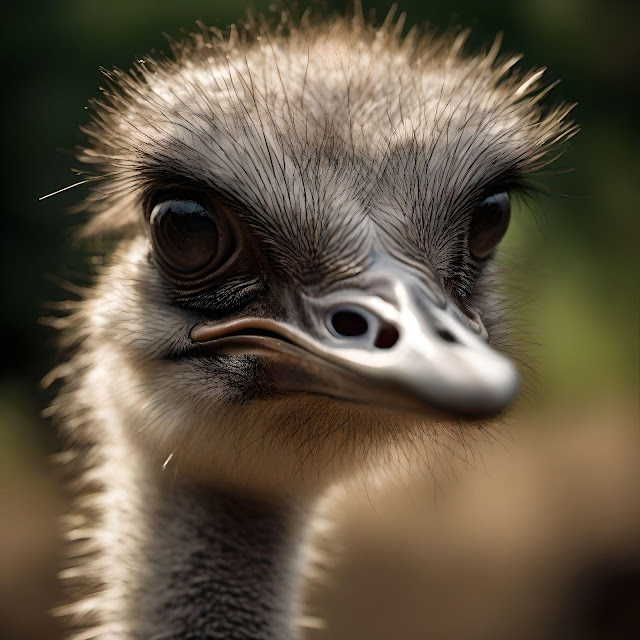The Secrets of the Ostrich: The Only Animal with Four Kneecaps
INTRO:
Some people just achieve too much. Take Bruce Dickinson, for instance: lead singer of Iron Maiden, qualified airline pilot, skilled fencer, and published novelist. It's almost unfair. But in the animal kingdom, there's an equally impressive overachiever: the ostrich. Not only is the ostrich the largest living bird species, but it also lays the largest eggs of any living bird, holding a Guinness World Record to prove it. And if that wasn’t enough, ostriches can run faster than most of us can drive in a school zone. But wait, there's more! The ostrich has another unique feature that sets it apart from the rest of the animal kingdom: it’s possibly the only animal to have four kneecaps. Yes, you read that right. Four. Kneecaps.
Outlines:
- Ostrich Anatomy
- The Marvel of Ostrich Physiology
- Evolutionary Whims
- Conclusion
Ostrich Anatomy:
A Peek Beneath the Feathers
Funny Bones: A Tale of Two Kneecaps
The discovery that ostriches have two kneecaps in each leg dates back to at least 1864, but the reason behind this peculiar anatomical feature has remained a mystery. To unravel this enigma, Sophie Regnault and her colleagues at the Royal Veterinary College in London took a closer look at this unusual bird. Using a single dead ostrich donated to the college, they alternately bent and straightened its knees, employing an imaging technique called biplanar fluoroscopy to track the movement of the bones. They also created a simple model to understand how the kneecaps affected the leverage of the muscles controlling the knee. “The upper kneecap looks similar to the single bone in ourselves and other animals,” says Regnault. But "the lower one is a little like the point of your elbow, very closely attached to the lower leg bone." Typically, kneecaps improve the leverage of the knee extensor muscles, allowing them to produce less force to straighten the knee. “It’s a bit like putting the door handle further from the hinge,” explains Regnault. “It requires less force to open the door.” But ostriches, ever the nonconformists, have an upper kneecap that seems to decrease the leverage of the knee muscles, not increase it. This might sound like a disadvantage, but it allows the ostrich to straighten its leg more quickly at the knee, albeit requiring more force. This could be the secret to their incredible running speed. Meanwhile, the lower kneecap—an anatomical feature most species lack—might be protecting the tendons crossing the front of the knee.
Knees Everywhere: A Comparative Perspective
It's hard to confirm these theories because the ostrich is unique, and no other animal with two kneecaps provides a basis for comparison. There is an 1884 report of another bird, a red-breasted merganser, having two kneecaps, but this hasn't been confirmed. Additionally, some frogs might have two kneecaps made of cartilage, but their vastly different lifestyle makes comparisons difficult. Bizarrely, many of the ostrich’s closest relatives, such as emus and cassowaries, don’t have kneecaps at all. In 2014, Regnault showed that these birds, and likely the extinct moa, lack kneecaps. However, kiwis and tinamou, which are also closely related, do have kneecaps. Regnault says, "It's a little perplexing why some species have them and others don't.". She suggests it might be worth investigating lizards, which haven’t been examined as closely as birds, to see if any of them have two kneecaps. In the end, there may not be a singular pattern or guideline dictating whether or not kneecaps are present. "Our research indicates that the ancestral families of birds, lizards, and mammals are separate evolutionary trajectories of the kneecap, so I wouldn't hold my breath for a single principle explaining why some animals have one or two kneecaps," Regnault said.
The Marvel of Ostrich Physiology:
Running on Kneecaps
The Upper Kneecap: A Speed Booster?
The upper kneecap of the ostrich, unlike its human counterpart, seems to be designed for speed rather than strength. By decreasing the leverage of the knee muscles, the upper kneecap allows the ostrich to straighten its leg rapidly, crucial for its high-speed running. This adaptation might be a trade-off, where increased speed is achieved at the cost of requiring more muscular force. In the high-stakes game of predator evasion, speed often trumps efficiency.
The Lower Kneecap: The Silent Protector
The lower kneecap’s role appears to be more protective. By shielding the tendons crossing the front of the knee, it prevents injury and ensures the ostrich can continue its high-speed escapades across the savannah. This added protection is vital, considering the immense stress placed on the ostrich’s legs during running.
Evolutionary Whims:
Why Two Kneecaps?
A Case of Convergent Evolution?
The presence of two kneecaps in the ostrich might be a case of convergent evolution, where similar features evolve independently in unrelated lineages due to similar environmental pressures. This phenomenon could explain why certain birds, lizards, and mammals have developed kneecaps independently.
The Absence of Kneecaps in Close Relatives
The absence of kneecaps in the ostrich’s close relatives, like emus and cassowaries, adds another layer of complexity. This variation suggests that the presence or absence of kneecaps might be influenced by specific ecological niches and evolutionary pressures unique to each species. For instance, the flightless lifestyle of ostriches and their need for rapid terrestrial movement might have driven the evolution of their unique knee structure.
Conclusion:
The Mysteries of the Ostrich Unveiled
The ostrich, with its four kneecaps, stands as a testament to the marvels of evolution and the endless possibilities of nature’s ingenuity. While the exact reasons behind this anatomical quirk remain shrouded in mystery, the current understanding suggests a fascinating interplay of speed, protection, and evolutionary adaptation. As we continue to study these incredible birds, we may uncover more secrets that shed light on the intricate mechanisms driving their unique physiology. For now, we can marvel at the ostrich—nature’s overachiever, running swiftly on legs that tell a story of evolutionary wonder and complexity.




very educative
ReplyDelete